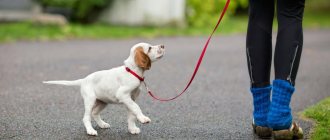You have a little fluffy baby, all his vaccinations have been completed, he is healthy and carelessly running around the house. One thing overshadows the peaceful coexistence of pet and owner - frequent puddles on the floor. You can't wait until you can train him to walk outside. When to start walking, how to do it correctly – we’ll look at it in this article. After all, a walk is not only a toilet outside the house, but also socialization of the puppy, physical activity, interaction with the owner and the absence of depression.
At what age can you walk a puppy?
Many owners are concerned about the question: at how many months can you start walking with your pet? There is no clear answer to this question. Everything will depend on the dog’s health. In order to start walking, the following conditions must be met:
- The dog must be healthy. This is necessary for primary vaccination. This means that parasite treatment must be carried out. The person himself will have to monitor this. Lethargy, lack of appetite and other alarming signs are a sign that walks should be postponed;
- The puppy must be vaccinated according to age. Most often, all vaccinations are given at two months of age. But it happens that as a result of illness, the vaccination date is postponed, and with it the opportunity to walk the puppy;
- The quarantine period after vaccination was maintained (2 weeks).
On the issue of vaccinations and quarantine, you should consult a veterinarian. If you have any doubts regarding the puppy’s health, visit a doctor.
Why do puppies need quarantine for the first 2 weeks after vaccination at 3 months?
Is it possible to wash a dog after vaccination: after how long is it allowed?
To protect the life of your pet, after a course of vaccinations, you must comply with quarantine. Animal immunity develops faster against a number of diseases, but protection against leptospirosis and rabies appears only 2 weeks after the course has been completed.
After vaccination, the dog's activity decreases for several days
After vaccination, the dog's behavior must be closely monitored. In the first three days, the dog is characterized by a decrease in activity. Babies may whine in fear. Side effects are also noted:
- refusal to eat;
- itching;
- lethargy;
- intestinal disorders;
- increase in temperature.
A veterinarian's consultation is required if your dog behaves in the following ways:
- The dog itches, chokes, the mucous membrane turns blue. All these are symptoms of anaphylactic shock.
- The temperature reaches 39 degrees, accompanied by weakness, cramps, vomiting and frustration.
Is quarantine mandatory?
Although it seems that vaccination is a fairly simple procedure, after it the dog’s body becomes weakened. During this period, your pet can contract a number of diseases that can be fatal. This is why quarantine is not only possible, but required.
In this case, it means complete isolation from society. If for an adult dog such restriction from the outside world is not necessary, then for a puppy it is vital.
Rules of conduct for 2 weeks after administration of the vaccine:
- Limit the puppy's interaction with other animals.
- Limit contact with objects that may contain viruses (outdoor shoes, etc.).
- Give up the idea of walking your pet.
- Avoid water procedures.
- Do not introduce changes to your usual diet.
- Reduce physical activity.
Important! During immunization, it is worth asking your veterinarian when the puppy can be taken outside. He will be able to determine the time period if the owner is afraid to make a decision himself, and will tell him when walking will be allowed.
How to train a puppy to walk
At first, while the puppy is small, you need to walk him as often as possible. Such outings should be short, so that he does not get tired, but regular. However, you should not expect quick adaptation and using the toilet strictly on the street. Home accidents will continue to happen for quite a long time.
If it is not possible to walk with your pet often, then make it a rule to do it regularly, choosing a time that is convenient for you. If you plan to walk the dog at the same time and in the future, such regularity will help teach the puppy to walk at the right time.
There are some basic rules that you should take into account during your first walks:
- At first, it’s worth walking away from everyone: cars, people and animals. If your child is afraid to go for a walk, do it until he finally gets used to being outside. To do this, use the same route;
- When going outside, if you do not have an elevator in your house, take the dog in your arms. Puppies, especially large breeds, should not climb stairs on their own due to their immature and fragile spine. No matter how touching it may look;
- If the weather is inclement outside, it is better to cancel your walk. Because the baby can become hypothermic and get sick. It is better to start your first trips outside at a temperature of at least ten degrees. Some breeds of dogs, for example, decorative ones, are not recommended for walking in winter, especially puppies;
- Protect your little friend on the street from other adult dogs. They may be sick or aggressive. Socialization is necessary, but an aggressive animal or very intense play can cause harm to the baby.
If you manage to walk your puppy regularly (up to five times a day), then over time he will begin to tolerate walking and will do everything he needs outside. He will look forward to walking with you as one of the best adventures of the day.
When can you start walking your puppy?
You can take the puppy for a walk or carry it in your arms if all the rules are followed at the same time:
- the animal is fully vaccinated, which will protect its body from infection with dangerous viruses;
- the puppy is treated against ectoparasites;
- the pet is healthy;
- the animal underwent a two-week quarantine after moving to new owners;
- the puppy can wear a collar and walk on a leash;
- the pet can wear protective overalls (for smooth-haired dog breeds in cold weather).
When is the best time to feed
Another important question arises - when is it better to feed, before or after a walk.
Since digestion occurs in several stages, starting with food intake and its mechanical processing in the mouth and ending with the absorption of enzymes, this is not a quick process. It happens much better and more effectively in a calm environment. Therefore, it is better not to feed the puppy before a walk.
A well-fed baby will resemble a clumsy ball and will lose interest in everything that surrounds him.
Safety on the street comes first
Train your puppy not to react to passing traffic. However, if your pet is afraid of something, switch his attention to the toy and calm him down. Do not allow barking at people passing by. If the puppy reacts inappropriately to passers-by, it is better to walk in deserted places for the first time. Go outside for the first time in warm, dry weather, not lower than 10 degrees. Make sure that the puppy does not freeze and moves actively and do not allow him to pick up anything from the ground. Just in case, hang a tag with your phone number on your dog's collar.
How to protect yourself while walking
It's no secret that the weather often brings unpleasant surprises. But for training, regular trips outside are necessary. And, if you can’t wait out the rain or other precipitation, you have to go outside, even for a short time.
In this case, it will be necessary to somehow protect the puppy’s fragile body from moisture and cold.
The stores offer a huge selection of different types of clothes for dogs, small in age and size. But you should remember that a baby needs clothes not to please everyone around him, but to protect his health.
Therefore, when choosing, you need to be guided by considerations of maximum protection. In autumn, preference is given to waterproof clothing, and in colder weather, warming clothing.
How long to wait before your first walk
When can you walk your puppy after the second vaccination?
Of course, any owner who is concerned about the health of their pet is interested in the question of when can they walk their puppy. The first walks should start smoothly. It is important that the dog can get used to the street and not be afraid of the surrounding vegetation and other pets.
The first walk with the puppy should be in warm weather
You also need to know at what age the puppy can be taken for its first walk. So, with strong and healthy pets, you can go for a walk at the age of one and a half months. There are two conditions for such a walk:
- the weather should be warm outside, that is, at least 10 degrees;
- The pet must be held in your arms.
In all other cases, the optimal age is 3 months, when the dog has already received a course of vaccinations. Already at this age, the puppy can walk on its own, and not in the arms of the owner.
The age at which you can walk your puppy also depends on the breed. For example, large guard breeds need to be accustomed to the street from childhood, unlike short-haired representatives. Therefore, it is necessary to organize walks at the age of one month. Decorative breeds do not tolerate bad weather, so the best solution would be to wait until they get stronger and are vaccinated.
Important! The puppy should be taken for a walk in your arms, since its bones are still weak, and it is forbidden for it to move on stairs. This is especially true for the French bulldog breed, which is vulnerable to various types of severity.
Pet owners should find out if their pet's mother is vaccinated. If she has had all her vaccinations, then by the time she gives birth she has strong immunity, which means that the puppy is protected from infection for up to 3 months. In this case, you don’t have to hold him in your arms while walking.
Decorative breeds, Yorkshire terrier, chihuahua, pug, spitz do not need constant walking. Yorkies and other decorative breeds are considered pocket dogs for this reason.
Walking activities
Initial walks should begin with the dog wearing a harness and on a leash. In urban environments, a leash is required. The dog is still too small, does not know commands and, if it gets too busy, can get into trouble.
Without a leash , allowing the puppy to run freely and explore the world, you can walk outside the city. And only if you are completely sure that the place is as safe as possible.
A walk is an excellent opportunity to exercise your pet physically.
Constantly monitor what the puppy is doing. The baby will most likely begin to pick up everything on the street that seems interesting to him. Is it dangerous. Therefore, you need to pull the leash towards you so that it moves away from the find and give the command “fu”, thus starting the training. In addition, during a walk, the owner must constantly interact with the baby and captivate him with games. After all, the learning process has just begun; constant attention is needed.
If the puppy is walking and stubbornly does not want to go to the toilet outside and tolerates going home, it is worth increasing the time of the walk. After everything has worked out, you need to praise him, thereby reinforcing the skill. In addition, at home it is worth cleaning the place where he most often relieves himself and washing it with a disinfectant solution that removes the odor.
sit on the ground during a walk , expressing their reluctance to walk. This happens because they are uncomfortable and scared. Don’t scold him, just stand next to him, carry him in your arms a little so that he gets used to the situation and gets used to it. It is worth letting other dogs sniff, even while sitting on the ground and looking around. This is very similar to the behavior of small children, they need time.
From the first walks, you need to start getting used to washing your paws after a walk. Choose a soft cloth and wipe your paws, even if they are barely dirty. The puppy will grow up, but the ritual familiar from childhood will remain.
Basic walking rules
When walking with your four-legged pet, you must remain clean and monitor the safety of others. All waste must be disposed of in special boxes or regular bins, so be sure to carry bags for cleaning up feces with you.
Walking in public places is strictly on a leash, regardless of the age, size and nature of the animal. Walking without a leash is allowed only in dog parks and outside the city, that is, in the most deserted places.
The requirements for wearing a muzzle are more flexible. It is mandatory only for representatives of certain breeds.
How many times should you go for a walk?
In the first month of walking, starting at the age of 2 or 3 months , frequent walks are necessary - five or six times a day. The frequency of walks is important here, but not their duration. If you notice that by 4 months the puppy has begun to cope better with toilet matters, you can reduce the number of trips.
With age, the number of walks will decrease, but their duration and intensity will need to be increased. By 5 or 6 months , most dogs have learned to do their business outside. That is, by 7 months you can reduce walking to four, or even three, times.
However, complete stabilization and adaptation should occur by the age of one year. It is enough to walk an adult dog twice a day. If your pet is experiencing problems by this time, it means that you made mistakes in training it to walk or there are health problems.
Why you can't walk your dog before vaccination
So, you bought a puppy and brought him into your home. In addition to the fact that you now have to love him and feed him properly, you need to immediately accustom your pet to order. With patience, affection and attention, you need to force the animal to do its little things, in a certain place. While you can’t walk outside with your puppy, purchase a special tray for him.
When can you go for a walk? The puppy can be taken out only after certain procedures have been completed. If you purchased a four-legged friend from a kennel or from a friend, in order to take the puppy out for walks, you will need to get him vaccinated first. Vaccinations are mandatory. While the dog is small, when walking on the street, he will sniff everything, pick it up in his mouth, gnaw and may even swallow something, so he can become infected with something, pick up an infection and get sick.
You can become seriously ill and lose your pet. Typically, puppies receive their first vaccination at six weeks of age in kennels. This is a vaccination against arboviral enteritis so that dogs do not become infected from each other. But this vaccination is not mandatory, although it is very dangerous for a small dog. Some breeders and unscrupulous dog owners may not vaccinate, since this does not pose a danger to humans. But enteritis is seriously dangerous for puppies. The weak ones may die altogether, and those that survive will acquire many defects during the growth process (improper jaw bite, paw placement, arched back, etc.). Therefore, it is imperative to make sure that this vaccination is done.
To avoid being deceived, it is best to take it to a veterinary clinic after purchasing a pet. After examining your dog, only a specialist will accurately determine whether he is healthy. They will also select the optimal vaccination schedule for your puppy. Remember that before the eighth week, one vaccination must already be carried out. At the age of 8 weeks, it is imperative to get a second vaccination against enteritis, distemper, adenovirosis, parainfluenza and leptospirosis. At the twelfth week, the third vaccination is given, against rabies. So at three months you must ensure that your pet is preventively protected from various diseases.
The dog's manners are an important factor in the walk.
To make the walk effective, you should teach your pet basic commands. You can let him off the leash and let him run around. The dog must know and respond to two phrases - “stand” and “toe”. During each walk, try to teach him something new so that not only his body, but also his intellect develops.
There are many manuals that present teaching methods. You no longer have to walk your dog on a leash. You can safely let her go for a run and explore the area on her own.
What should I take with me?
Some people believe that toy dogs do not pose a danger to others due to their size. In fact, this is not entirely true: the bite of a mini dog is quite painful due to the fact that decorative breeds actually strongly pinch soft tissues.
Be sure to take a leash with you. It is up to the owners to choose between a collar or harness. The first one looks more attractive, and the second one does not cause discomfort to the dog. Is it worth getting a muzzle? If you are going to a park or places where there will be children, then it is best to take it with you. Even if your dog is the calmest and most loving, only you know this fact, while others can logically be asked to put a muzzle on their pet and they will be absolutely right.
On a hot day, you can additionally take a bottle of water for your dog. And during a long walk, toys for active games in the fresh air will come in handy.
How to avoid problems?
In order for you and your pet to have complete mutual understanding, constant training and discipline are required. This is the only way you can achieve the desired result, earn trust and have a good time with your favorite animal.
Show leadership
First, you will definitely need to create a walking strategy. It is quite common for the pet to lead the walk, not the owner. To avoid this, you need to show your dominance.
If the dog tries to chart his path, stop these attempts by calling him to you. In cases where he tries to run away for a long distance, call him back. This way your pet will always remember your presence.
Encourage your pet the moment he runs up. This will help build trusting relationships. The dog will know that you have something tasty for him.
You can practice playing with some kind of toy. Throw it at a distance, the dog must grab the object and return it back. This is a fairly common training tactic.
What does a full walk include?
Let's figure out how to properly walk a dog. This is a kind of ritual, which must include the following actions:
- do all the dog's business;
- run several times for at least ten minutes;
- communicate with other representatives of the canine family;
- walk next to the owner to strengthen the psychological connection;
- teaching several new commands and reinforcing old ones - prepare some kind of treat as an incentive surprise.
This is a complete procedure, like walking a dog. This walking scheme will benefit both the owner and the pet. The dog will visit new places, communicate with relatives, run, and relieve itself. He will be tired enough to rest when he gets home. Of course, it is not always possible to allocate the required amount of time for a full walk, but it is still worth trying to find a “golden mean”.
Comprehensive vaccination for the baby. Basic moments
Dogs are susceptible to infectious diseases. Puppies are especially sensitive. The probability of infection of an unvaccinated pet within the city is very high. Vaccination is an effective way to prevent viral infections in dogs.
The vaccines with which a puppy is vaccinated are either against one disease or against several diseases at once (up to five diseases in one injection). The breeder from whom you purchased the puppy or the veterinarian at the clinic will help you choose the appropriate vaccine for your pet.











